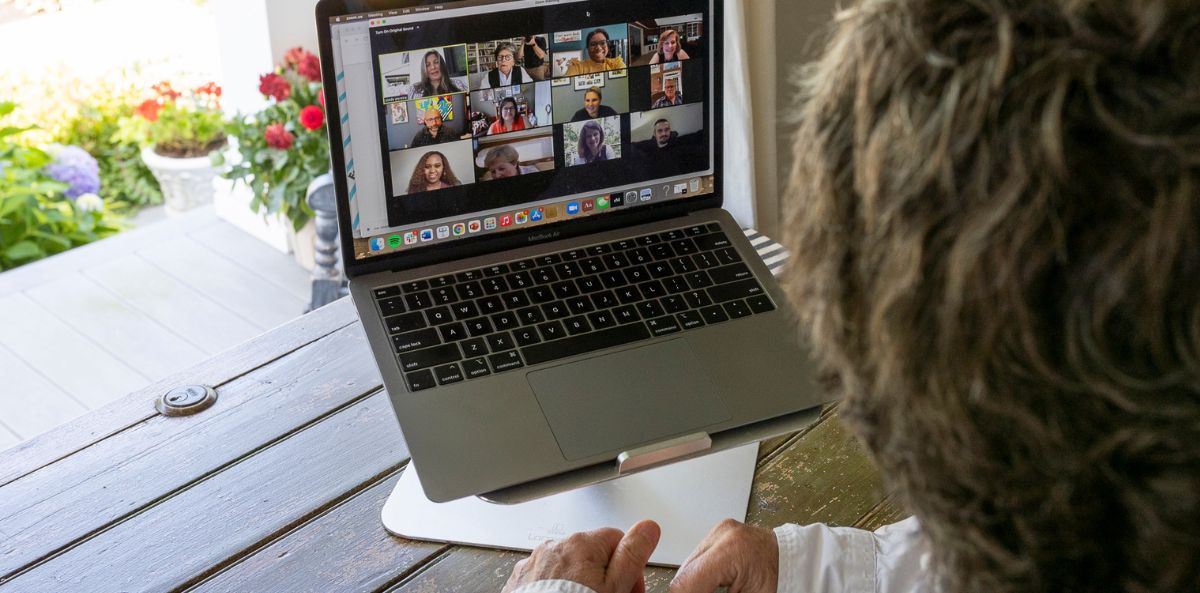In the ‘before times” (pre-pandemic) I operated my firm and the Nonprofit Leadership Lab with a hybrid work model. It just happened that way. A few people were working remotely, but most of the team came to work every day in our office here in Montclair, NJ because I started growing my company the old fashioned way.
That said, my business partner has always worked remotely from his home office near Baltimore. As the business grew, we added folks from four more states in three different time zones.
At our office in NJ, we ate lunch together, had inside jokes, and ad hoc conversations. I loved the office vibe – it’s a great group of people and it was quite fun to come to the office every day.
But it was also a problem.
I never thought much about it if I’m being honest. But we really should have found a way to include more of our remote folks in all the camaraderie. We were one team, but those who were working remotely were a collection of individuals who felt left out.
Today, our team is larger and more geographically diverse. We’ve added two more states. We still have that NJ office. I am the only one who uses it.
We now operate in a fully remote model. I have team members I have not met in person (yet). So I have led with both the remote and hybrid work models.
And guess what? I vote for a remote workplace.
Our team culture is much stronger. Everyone’s Zoom box is the same size. No one has what is perceived to be special access. I believe people feel a greater sense of belonging than in our pre-pandemic hybrid work model.
A few months ago, I thought about suggesting that our local folks come to the office 1-2 days a week. Then my business partner, Scott, shared how he felt about the hybrid set up…
“When a subset of the team works in the same physical location as the founder, for everyone else you don’t just feel left out. You can feel a kind of paranoia — are they making decisions without my input? What are they saying about me?”
After that conversation, I understood that a hybrid workplace made it very difficult to create a real sense of belonging for our team. And if you don’t work intentionally to create a true sense of belonging in your workplace – especially amongst those working remotely – you will not retain your top talent.
Our shift to a fully remote workplace from a hybrid work model has turned me into a champion for a remote work model. The champion thing stems from understanding that in order for a remote work model to succeed you must double down on building a real sense of belonging.
And I have some practical ideas for nonprofit executive directors, board members, managers, and HR professionals in the nonprofit sector who are looking for ways to bring their remote teams together.
You CAN Make The Hybrid Work Model Work
Some organizations have no choice — I get it. If you are a direct service organization for example, lots of your people can’t work remotely. I have the luxury of choosing.
If you don’t have that choice, you must embrace intentionality. I learned this from my friend and expert on gatherings, Priya Parker. Priya had zero idea that her super power would become mission critical to many of us beginning in 2020. Check out this recent podcast episode I did with her about how hybrid meetings can be remarkably effective, and learn more about her work at priyaparker.com. Or listen to her NY Times podcast, Together Apart.
How To Create A Culture of Belonging in a Remote Workplace
Whether your org has a hybrid work model or a remote work model, one thing’s for sure: It’s much more challenging to foster a sense of belonging across your team when everyone’s not in the same place — but it’s not impossible.
In fact, there are 10 things that I think really helped our team get there.
- Welcome New Folks With Intention
A new employee’s first day at their job could be just that person at their kitchen table. Not exactly a warm welcome. A package should be sent to a new employee – not just an employee manual and a budget. Include something thoughtful. Swag if you have it. A GrubHub gift certificate for a virtual day 1 lunch date with the new boss.
And please don’t forget to include something on day 1 that ignites your new team member about the power and meaning of your work – a link to a video, testimonials from clients.
- Not Just Zoom Meetings
There are a few apps we like that help all of us working remotely feel like we’re together.
- Slack. Hardly transactional for us. It’s often our water cooler – We have a #morningannouncements channel to get our days off to a good start. We keep track of high school and college graduations, grandkid milestones, the dates of a staff member’s band’s east coast tour. And another channel, #kudos, where we share what our clients and members say about the value of our work.
- Bonjoro. Personalized video app sent in an email. They are awesome. For a big organization where the leadership is not as able to connect regularly, these can be great.
- A Spontaneous Phone Call. It’s funny how the phone used to feel detached. Now, a call with no agenda is like just stopping by.
- Show Folks You Care
It started with Covid. A diagnosis on our team means an InstaCart gift card. Our version of chicken soup. Another thing we discovered – electronic customizable cards – you can include customized notes – for weddings, sympathy, birthdays. We use www.ellacards.com.
- Colleague Appreciation Opportunities
This can be time in a team meeting dedicated to a few folks sharing the life journey that brought them to your organization. It can be giving them the spotlight to share something they are working on.
In the case of my colleague Miguel Espinal, I’m thinking about asking folks to share why his latest nickname is Octo-Man (spoiler alert: he is our web developer who can design reports, pull data, fix bugs, and write hilarious comments in the zoom chat — all at the same time!).
Or consider having a team member teach or facilitate. We want to learn to appreciate all that our colleagues bring to the table.
- Create Cross-Department Working Groups
The remote work model can create silos, right? I do my thing, you do yours. Silos don’t benefit anyone, regardless of where they work. And folks want and need to know that their voice matters.
Right now my team of nearly 20 has four of these working groups – a member experience group, a marketing group, a DEI group, and currently a retreat planning working group. If the meetings are designed and run with intention, people love mixing it up and stretching different muscles in different areas of your organization.
An added bonus: the people at the top don’t have to run these. They can give your org new ways to offer leadership/ professional development opportunities. Be prepared to coach folks in these leadership roles and that time will pay dividends.
- Co-create Annual Goals With Quarterly Check-ins.
This is so important to flexibility and trust. Every staff member must have a clear role with clear goals. Then check-ins where you untangle what’s getting in the way. This is how accountability is introduced. And regular assessments can lead to adjustments or other team conversations to untangle knots.
- Get Together In Person Once A Year
It’s important to design a five-star in-person annual gathering. Build a cross functional planning group to ensure shared ownership. Set clear goals that must include appreciation, lots of white space for people to just connect and time for all voices to be heard as the future strategy is considered.
- Touch the Work
When team members feel detached from the impact the organization is having, you end up with a morale problem. Meeting a client, seeing the work in action, hearing a keynote speech from the leader, or sharing media coverage are ways remote workers can “touch the work.” Clearly a remote work model can present challenges for direct service nonprofits with staff members in different roles. The key is communication. That said, there are many ways for folks to touch the work and a team brainstorm may be helpful. Also, if some folks have to be on site, talk about that! How do you create an equitable playing field? Get creative.
- No Divas Allowed
You simply can’t allow any team member to hold you hostage as you build your culture. Many orgs develop policies and then walk them back because staff balk.
Let’s say you provide direct service and there is a need for a hybrid work model. What do you do when someone says, “If I have to come in, I’m going to find another gig where I can fully work remotely”? Did you engage that person in developing the policy? How are you communicating? Are you communicating with care? Is it possible this person should find a different environment? Maybe.
I suppose this is the challenge I have with policies in general. Can’t live without ‘em most of the time and yet, our new world order demands a kind of flexibility that is wildly foreign to many of us and may not allow us to recruit and retain the best folks.
- Get Funny and Stay Funny
Not everything will go perfectly. Duh. Having a sense of humor will be essential. Whether we are talking cheesy icebreakers or technical difficulties. Lighten up (this typically comes from the top).
Yes, your work is serious but that doesn’t mean you have to take yourself too seriously.
Here’s hoping these ten ideas generate good thinking on your team and help to develop ideas that really speak to your organization and help all of your remote workers, whether you have a remote or hybrid work model!
The future of work is here. And, in this brave new world of working remotely — where coffee breaks have turned into puppy breaks and office attire can mean pajamas — fostering a culture of belonging, appreciation, and co-creation is more critical than ever.
And don’t forget your sense of humor — there’s always room for a good laugh, even when your cat decides to moonwalk across your keyboard in the middle of a Zoom call. After all, who said changing the world couldn’t be fun?
*****
Curious about what it takes to be an outstanding nonprofit leader? Join me for this free workshop, where I’ll dive deeper into the practices, mindset, and leadership skills of the nonprofit sector’s top superheroes, and help you to fully understand the difference between nonprofit and for profit leadership.



